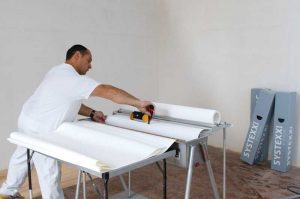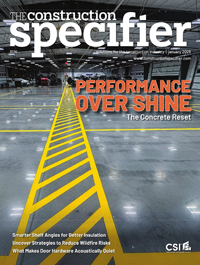Glass fiber textile
Level 5 is intended for walls decorated with semi-matte and gloss paints or other glossy decorative finishes, dark/deep tone paints, or walls where there are critical lighting conditions. Side-lighting on walls or ceilings, whether natural or artificial, creates so-called critical lighting conditions as it makes any texture or unevenness in the surface cast sharp shadows. Level 5 requires all the same work done for the Level 4, plus a skim coat of joint compound that covers 100 percent of the wall, which also must be sanded. Obviously, these operations are labor intensive. Labor accounts for approximately 75 percent or more of the cost of hanging and finishing drywall, depending on the local labor market. The finishing cost is entirely labor.
They are also time-consuming, with waiting periods for joint compound to harden, and extensive time sanding between coats. The dust created by sanding also tends to deter other trades from working in the space, so everything else stops while drywall finishing is underway. The drawn-out length of the finishing process increases costs related to the construction schedule.

The existence of five different finishing levels, as opposed to a single standard, is an accommodation to save money on walls whose substrate will not be publicly visible, either because it is completely concealed by a wall covering, or it is not in an occupied area. This is an indirect acknowledgement of the excessive cost of finishing drywall for appearance.
The glass fiber textile alternative
An alternate approach to achieve the equivalent of a Level 5 finish is to cover the wall with a paintable fabric. It is much faster and less labor-intensive than a joint compound finish and, even with a higher material cost for fabric, it is less expensive overall.
Glass fiber textile, either unwoven or woven, can be adhered to the wall with a seamless appearance, and then painted or papered. Depending on the fabric, it can achieve a smooth surface or a perfectly textured surface, with a wide variety of weaves available for different appearances and special performance applications. Whether the finish is smooth or textured, the surface is consistent and contiguous. It can be painted as though it were drywall. Pre-primed products take paint better than drywall does and can save significant cost and time on painting by reducing the number of coats needed to cover the wall.
Applying a smooth, non-woven glass fiber textile—sometimes referred to as fleece—effectively conceals fine details in the drywall substrate but presents a similarly textureless wall surface. If the drywall is brought to a Level 1 or Level 2 finish and then covered in glass fleece, it will present a defect-free surface equivalent to a Level 5 drywall finish. It also makes the surface stronger and more resistant to abuse and damage.
How it works
To finish a wall or ceiling with glass fiber textile, the drywall should first be brought to a Level 2 finish: panel joints taped by embedment in joint compound and wiped with a knife to leave a thin coat of compound over the tape; and fastener heads covered with one coat of compound.

The wall is primed with a sealer, typically using a low-pressure sprayer, to remove excess dust and prepare the surface for proper bonding with the textile glue. Then, fabric is adhered to the wall. Glass fiber textile is available pre-glued or unglued. For an unglued fabric, the adhesive is spread onto the wall using a paint roller, like dry-hanging wallpaper. Both starch-based and vinyl-based adhesives are suitable. Most glass fiber textile is supplied in rolls, typically 991 mm (39 in.) wide. A length of fabric equal to the ceiling height plus 51 to 100 mm extra (2 to 4 in.) is cut from the roll and hung on the wall. The fabric is smoothed down to the wall with a roller or a specially designed spatula, being careful to remove any wrinkles, bulges, or air pockets. Glass fiber textile can be repositioned for some time before the adhesive sets; exact working time is dependent on the specific adhesive and the ambient temperature and humidity.






